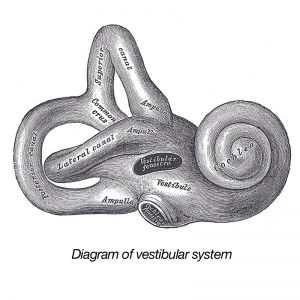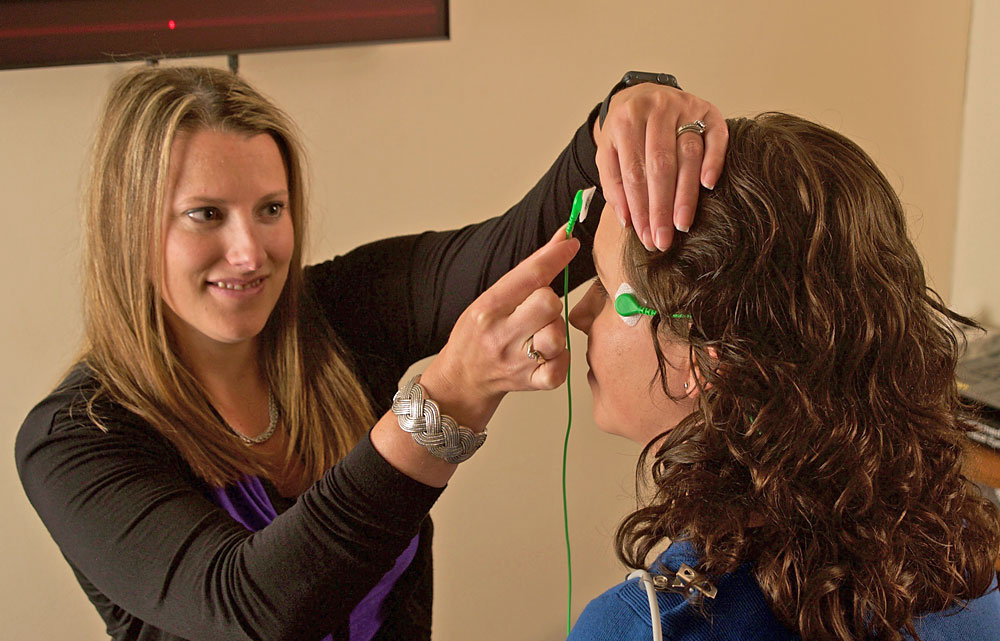Balance, Dizziness and Vertigo
The Wichita Ear Clinic has specialized in the diagnosis and treatment of balance disorders for over 20 years.
The Wichita Ear Clinic has specialized in the diagnosis and treatment of balance disorders for over 20 years.
Balance Explained
 Balance is maintained by the interactions in the brain of nerve impulses from the inner ear, the eye, the neck muscles, and the muscles and joints of the limbs. Balance requires the interaction between many different organs and systems in the body. Input comes from three main areas:
Balance is maintained by the interactions in the brain of nerve impulses from the inner ear, the eye, the neck muscles, and the muscles and joints of the limbs. Balance requires the interaction between many different organs and systems in the body. Input comes from three main areas:
A disturbance in any of these areas may result in the sensation of dizziness or unsteadiness. General disturbances of body function (blood pressure, blood chemistry changes, brain function) may also lead to dizziness by interfering with coordination of the impulses of the brain.
It’s important to understand the terms associated with dizziness and vertigo:
Vertigo – The feeling that you or your surroundings are moving or spinning.
Imbalance – Inability to keep one’s balance especially when standing and walking. Often there is a feeling of being wobbly and unstable.
Lightheadedness – The feeling of nearly passing out, similar to the feeling you might have if you hold your breath for a long time.
Dizziness – A general term for all symptoms of balance and instability.
The terms vertigo and dizziness are often confused. Vertigo refers to when patients experience an abnormal sensation of movement, generally a spinning or rotation of the surrounding environment or of the body. Dizziness refers to a feeling of imbalance, lightheadedness, blacking out, staggering, disorientation, weakness and other sensations.
Dizziness and imbalance can be grouped into types by the portion of the entire balance system that is not working properly.
Symptoms can range from mild and brief to more severe sensations accompanied by nausea. It is helpful to characterize the symptoms clearly so an accurate diagnoses may be achieved.
Common disorders causing vertigo include benign paroxysmal positioning vertigo (BPPV), vestibular neuritis, migraine associated vertigo and Meniere’s disease. Imbalance and disequilibrium include central dizziness, persistent postural perceptual disequilibrium (PPPD), cervical dizziness and post-concussive. Many forms of balance disorders do not involve the inner ear but are able to be treated. After diagnosing the problem various treatment modalities including medical, surgical, and vestibular rehabilitation can improve overall balance function.
Types of Dizziness
Visual Dizziness
The brain relies on information from the eyes to help with balance by giving information about our position in space and movement of objects. Eye muscle imbalance, poor vision and other vision disorders can make one’s balance worse. Motion sickness (car or sea sickness) is a type of visual dizziness. Sometimes, changing glasses and adding trifocals to our corrective lenses can lead to balance trouble.
Inner Ear Dizziness
When the portion of the inner ear responsible for balance (vestibular labyrinth) malfunctions generally vertigo is experienced. These problems usually cause imbalance, vertigo (spinning), and nausea. They may also be associated with tinnitus and hearing loss if the hearing part of the inner ear (cochlea) is also affected.
Central Dizziness
Central dizziness is caused by problems in the balance portion of the brain. Anytime this portion of the brain is not working properly, symptoms of dizziness and general imbalance may occur. Symptoms usually include lightheadedness, disorientation, imbalance, and sometimes even blacking out. Causes of central dizziness are many and treating these types of dizziness usual involves treating the problem that is causing the brain to not work properly. Often physical therapy for the balance system (Vestibular Rehabilitation) can be of help.
Muscle – Joint Dizziness
If the muscles, joints or touch sensors of the limbs are not working well, it becomes difficult for the brain to determine our position in space and makes it difficult to react to motion and remain upright. Symptoms are usually imbalance and unsteadiness. Diabetes can cause trouble with the feeling in our feet but overall this type of dizziness is uncommon.
Types of Vertigo
Benign Paroxysmal Positional Vertigo (BPPV)
This is a common form of positional vertigo. Frequently the patient will note rolling over in bed or looking up will produce a short burst of vertigo. There are several repositioning maneuvers use to treat BPPV (Epley, Semont, etc).
Meniere’s Disease
This type of vertigo lasts hours and has an associated hearing loss (typically in one ear), tinnitus, and a pressure sensation in the ear. There are a variety of medical treatments, office procedures, and surgical procedures to treat Meniere’s disease.
Vestibular Neuronitis
This type of vertigo is believed to be caused by a virus. Typically the patient has severe vertigo that lasts at least 24 hours and then has motion induced symptoms for weeks. Steroids and vestibular rehabilitation are the treatment of choice. If there is also a sudden hearing loss we call it labyrinthitis.
Vestibular Migraine
This vertigo occurs in those with migraine headache. The patient usually has headache and sensitivity to light and sound with nausea. Typically vertigo or sensitivity to motion occurs before or after the headache. Treatment consists of prophylactic migraine medication and a migraine diet.
Central Vertigo
This type of vertigo originates from the central nervous system. Entities such as multiple sclerosis, strokes, and head trauma may cause central vertigo. Treatment is aimed at the underlying central problem and vestibular rehabilitation.
Superior Semicircular Canal Dehiscence Syndrome
This type of vertigo results from a dehiscence of the superior semicircular canal. It usually presents with hearing loss and vertigo when subjected to a loud noise. Treatment consists of avoiding loud noise or resurfacing the semicircular canal.
Persistent Postural-Perceptual Dizziness (PPPD)
This type of vertigo presents as a constant hypersensitivity to motion. Vestibular rehabilitation and SSRI medications are the treatment of choice.
Testing
 Because dizziness and vertigo can be caused by disturbances to many different parts of the body, the history and physical findings are the most important part of diagnosing the trouble. Often however, further testing of the balance system is required to complete a full evaluation.
Because dizziness and vertigo can be caused by disturbances to many different parts of the body, the history and physical findings are the most important part of diagnosing the trouble. Often however, further testing of the balance system is required to complete a full evaluation.
A complete hearing test is almost always done in order to establish the level of hearing and any indication of inner ear involvement in the dizzy process.
The most common test for dizziness is the electronystagmogram (ENG) or videonystagmogram (VNG). These tests involve recording the eye movements after placing warm or cool air into the ear canal. The strength of each inner ear is determined as well as the coordination of eye movement. This is usually well tolerated and causes a brief sensation of dizziness.
Positional testing (Dix-Hallpike) is also an important test of balance. This test looks for vertigo caused by different head positions and rolling over.
Other tests that are done for dizziness are the electrocochleography (ECoG) and the rotary chair test. These painless tests may be useful in determining the cause of dizziness in complex cases
It is important not to be taking any medications that can affect the results of these tests such as Valium, Antivert, alcohol and others. When scheduling this test make sure to ask if your medications will impact the outcome of the tests.
Imaging studies (CT or MRI scans), blood tests, and ultrasound tests are not routinely ordered. Your physician will order these tests if they feel they are necessary.
The diagnosis of vertigo and balance disorders can often be difficult. Frequently multiple tests and visits must be conducted. The goal of completing a thorough history, physical examination and testing are to try and make an accurate diagnosis, which can lead to effective medical treatment. Some dizzy problems come and go and require patience and understanding on the part of the doctor and patient alike.
Balance Exercises
Vestibular Rehabilitation Therapy
For many, compensation occurs naturally over time, but for those whose symptoms do not reduce and continue to have difficulty, VRT can assist in recovery by promoting compensation.
VRT is also of significant benefit for fall prevention in those who may suffer from multiple sensory and motor impairments or for those who have sensory disruption with moving visual information.
VRT can sometimes be tedious; however, committing to doing the exercises is key to helping you achieve success. Setting up a regular schedule so that you incorporate them into your day is very important.
These exercises may, at first, make your symptoms worse. But with time and consistent work, your symptoms should steadily improve, and then, you will find that you are able to participate more in the activities of your daily life.
It is very important to move your head and eyes together in every exercise. Even when your eyes are closed, you need to imagine that your eyes are moving with head movements.
When your eyes are closed, you may feel more off balance. For this reason, it is best to sit in a chair with handles or a couch to prevent falls. You may start with very slow head movements and pick up the pace as you feel comfortable. The most important thing is moving head and eyes together.